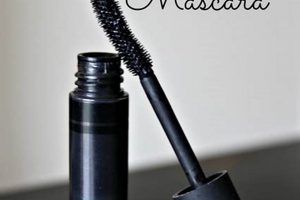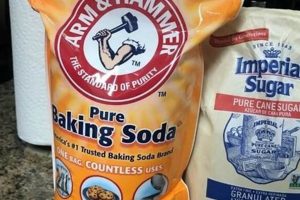Creating customized receptacles using room-temperature vulcanizing (RTV) rubber allows for the replication of three-dimensional forms. This process, achievable in a home setting, involves encasing an original object, known as a master, in a liquid silicone mixture that, upon curing, solidifies into a flexible negative space. The resulting cavity can then be used to cast duplicates of the original master, using various materials such as resin, plaster, or even food items like chocolate.
The ability to produce individualized forms opens numerous avenues for creative expression and practical applications. From crafting personalized jewelry components and artistic sculptures to generating replacement parts for household items or creating custom baking implements, the benefits are wide-ranging. This approach bypasses the need for mass-produced components and offers a cost-effective solution for small-scale manufacturing and hobbyist endeavors. Historically, similar techniques have been employed by artisans and manufacturers for centuries, albeit with different materials, demonstrating a persistent need for replicating shapes and designs.
The following discussion will detail the specific materials, tools, and step-by-step procedures involved in executing this molding technique. Subsequent sections will then address common challenges encountered during the process and provide methods for troubleshooting and achieving optimal results. Further exploration will consider the diverse applications of these fabricated forms across various disciplines.
Fabrication Guidance
The following guidelines provide critical considerations for ensuring the successful execution of the molding process, addressing potential challenges and optimizing the final outcome.
Tip 1: Degassing Prior to Curing: Prior to allowing the silicone mixture to cure, vacuum degassing is critical. Entrapped air bubbles can compromise the integrity of the mold, leading to surface imperfections in subsequent castings. Utilize a vacuum chamber and pump to remove these bubbles for a smoother finish.
Tip 2: Master Preparation is Paramount: The original object, or master, must be thoroughly cleaned and free of any contaminants that could interfere with the silicone’s curing process or leave unwanted textures on the mold’s surface. A release agent appropriate for the silicone type should be applied to facilitate separation after curing.
Tip 3: Consider a Two-Part Mold for Complex Geometries: For objects with significant undercuts or intricate details, a single-piece mold may be impossible to demold without damaging either the mold or the casting. Constructing a two-part, or multi-part, mold allows for disassembly and extraction of the cast object.
Tip 4: Accurate Measurement and Mixing: Precise measurement of the silicone base and curing agent is essential for proper polymerization. Use a digital scale for accuracy and adhere strictly to the manufacturer’s recommended ratio. Incomplete mixing can lead to uncured or partially cured areas within the mold.
Tip 5: Reinforce Thin Sections: Areas of the mold that are particularly thin are susceptible to tearing during demolding. Reinforce these sections by incorporating a fabric mesh or layering additional silicone to increase their structural integrity.
Tip 6: Test Cure a Small Batch: Before committing a large volume of silicone, mix and cure a small test batch. This allows for verification of proper curing ratios and identification of any unforeseen reactions with the master object.
By meticulously attending to these details, the creation of durable and accurate forms becomes more readily achievable. Adherence to these principles minimizes waste, reduces the likelihood of flawed molds, and ultimately yields a superior product for casting purposes.
With a solid foundation of techniques and solutions, the subsequent sections will delve deeper into advanced methods and further applications, enabling a greater level of creative exploration.
1. Material Selection
The selection of appropriate materials is paramount in the creation of durable and effective molds. The characteristics of the chosen silicone directly influence the mold’s flexibility, tear resistance, chemical compatibility, and ultimately, its lifespan. Careful consideration of these factors is crucial for successful replication of objects.
- Silicone Hardness (Shore Hardness)
Shore hardness, typically measured on the Shore A scale, indicates the silicone’s resistance to indentation. Softer silicones (lower Shore A values) offer greater flexibility, facilitating the demolding of intricate or delicate objects. Conversely, harder silicones (higher Shore A values) provide increased durability and dimensional stability, making them suitable for molds used repeatedly or for casting heavier materials. The specific application dictates the optimal hardness range. For example, replicating a fragile antique would necessitate a lower Shore A value, while a mold for concrete casting requires a significantly higher value.
- Tear Strength
Tear strength quantifies the silicone’s resistance to tearing or ripping. Higher tear strength is essential for molds used with materials that exhibit significant shrinkage during curing or demolding. It also extends the mold’s lifespan by preventing damage from repeated use. Certain silicone formulations are specifically designed for high tear resistance, often incorporating additives that enhance the material’s cohesive strength. This is particularly relevant when casting materials with sharp edges or intricate geometries, where stress concentrations can lead to premature tearing.
- Chemical Resistance
The chemical resistance of the silicone must be compatible with the casting material. Some resins, such as epoxies or polyurethanes, can react with certain silicone formulations, causing degradation or even inhibiting curing. Selecting a silicone specifically formulated for resistance to the intended casting material is crucial. Manufacturers typically provide data sheets outlining the chemical compatibility of their products, allowing for informed decisions. For instance, a silicone intended for food-safe applications must be resistant to the acids and oils present in various food items.
- Shrinkage Rate
All silicones exhibit some degree of shrinkage during the curing process. Minimizing shrinkage is critical for maintaining dimensional accuracy in the replicated object. Manufacturers provide shrinkage rate specifications, typically expressed as a percentage. Lower shrinkage rates are generally preferred, especially when dimensional precision is paramount. Some silicone formulations are designed with minimal shrinkage characteristics, often achieved through the inclusion of specific additives. The choice of silicone with appropriate shrinkage rate is especially important in prototyping and manufacturing applications.
In summary, the successful creation using this molding technique hinges on a thorough understanding of silicone properties. Choosing the right mat
erial for a specific project guarantees mold durability, accurate replication, and optimal performance, ultimately enhancing the overall quality and longevity of the castings produced.
2. Master Preparation
Master preparation is an indispensable precursor to crafting a mold. The fidelity of the resultant mold hinges directly on the condition and treatment of the original object. Any imperfection, residue, or inappropriate preparation will be faithfully replicated, impacting the final cast piece.
- Cleaning and Surface Treatment
Thorough cleaning is essential to remove dust, oils, or any contaminants that might impede silicone adhesion or compromise surface detail. Depending on the master’s material, appropriate cleaning agents should be employed. For porous materials, sealing may be necessary to prevent silicone from penetrating and adhering permanently. Consider that an untreated wood master may absorb the silicone, whereas a metal master may require degreasing.
- Sealing Porous Materials
Porous materials like wood, plaster, or unglazed ceramics require sealing to prevent the silicone from penetrating their surfaces and becoming permanently bonded. Sealants such as acrylic sprays or varnish create a barrier, allowing for clean separation of the master and the cured mold. Failure to seal porous materials can result in damage to the master during demolding, and a mold with unacceptable surface characteristics.
- Application of Release Agent
A release agent facilitates the separation of the master from the cured silicone. Different release agents are compatible with different silicone types and master materials. Application must be even and thorough, covering all surfaces that will contact the silicone. Improper application can lead to adhesion, tearing during demolding, or unwanted surface textures on the mold. Examples of release agents include petroleum jelly, silicone sprays, or specialized mold release compounds.
- Positioning and Support
The master must be positioned securely within the mold box or containment structure to prevent movement during the silicone pouring and curing process. Adequate support structures should be implemented to prevent deformation or sinking of the master, ensuring uniform mold thickness and accurate replication of the object’s geometry. For example, a clay base might be used to elevate and stabilize an awkwardly shaped master.
Neglecting any of these master preparation steps invariably leads to compromised mold quality, increased difficulty during demolding, and a reduction in the overall lifespan of the resulting mold. The direct correlation between preparation quality and mold performance underscores the importance of meticulous attention to detail in this initial phase.
3. Mixing Ratios
The integrity of a do-it-yourself silicone mold is inextricably linked to the precision of mixing ratios between the silicone base and the curing agent. Deviation from the manufacturer’s specified proportions initiates a cascade of adverse effects, culminating in a mold that fails to meet functional requirements. An insufficient amount of curing agent results in incomplete polymerization, leaving sections of the mold tacky or entirely uncured. Conversely, an excess of curing agent can accelerate the curing process to an unmanageable rate, potentially causing the silicone to become brittle and prone to cracking. The correct ratio ensures proper cross-linking of the polymer chains, yielding a flexible yet resilient mold capable of withstanding repeated use.
Consider a scenario where a user, attempting to create a mold for resin casting, neglects to accurately measure the silicone base and hardener. If the hardener is under-measured, the resulting mold may appear solid initially, but after repeated castings, the resin leaches into the silicone, causing it to swell and distort. This renders the mold unusable and necessitates the creation of a new one, incurring additional material costs and time investment. Conversely, an overabundance of hardener might create a mold that is too rigid, making demolding difficult and increasing the risk of tearing the mold or damaging the cast object. The consequences extend beyond mere inconvenience; they impact the reproducibility and quality of subsequent castings.
In conclusion, adherence to precise mixing ratios represents a cornerstone of successful fabrication using this molding technique. Overlooking this seemingly simple step can lead to significant setbacks, compromising the mold’s structural integrity and ultimately hindering the creative process. Therefore, meticulous measurement and thorough mixing are not merely recommended, but essential for realizing the full potential of creating individualized forms.
4. Bubble Removal
The presence of air bubbles represents a significant impediment to the quality and functionality of a silicone mold produced in a home setting. These bubbles, introduced during the mixing of the silicone base and curing agent, create voids within the cured material. The result is a weakened mold structure, susceptible to tearing and premature failure. Furthermore, bubbles residing on the mold’s surface create imperfections in subsequent castings, replicating as unwanted protrusions or indentations. Consider the creation of a mold for jewelry making. Bubbles present on the mold’s surface will translate into blemishes on the finished jewelry piece, detracting from its aesthetic value and potentially requiring extensive post-processing to correct. The effectiveness of bubble removal directly correlates to the mold’s longevity, casting accuracy, and the overall quality of the objects it produces.
Several methods are employed to mitigate bubble formation and ensure their removal prior to curing. The most effective technique involves vacuum degassing, where the mixed silicone is placed within a vacuum chamber. The reduced pressure causes trapped air bubbles to expand and rise to the surface, where they dissipate. Alternative techniques, suitable for smaller projects or situations where vacuum degassing is not feasible, include tapping or vibrating the mold container to encourage bubbles to rise. The use of specialized mixing techniques, such as slow, deliberate stirring, can also minimize air incorporation during the initial mixing phase. Each of these strategies aims to eliminate air pockets, ensuring a homogenous silicone structure capable of accurately replicating intricate details.
Effective bubble removal constitutes a critical step in the molding process. The absence of air inclusions guarantees structural integrity, enhances casting precision, and prolongs the mold’s usable lifespan. Despite requiring additional effort and potentially specialized equipment, the benefits of bubble removal far outweigh the costs. Without this crucial step, the integrity and value of the mold become questionable, jeopardizing both the creative process and the final product.
5. Curing Time
center>
Curing time represents a critical variable in the creation of silicone molds. It dictates the point at which the liquid silicone transitions to a solid, flexible state. The duration of this process directly influences the mold’s final properties, including its durability, flexibility, and ability to accurately replicate the master object.
- Impact on Mold Strength and Flexibility
Insufficient curing time results in a mold that is structurally weak and prone to tearing during demolding or subsequent casting processes. The silicone remains partially polymerized, lacking the necessary cross-linking to achieve optimal strength and elasticity. Conversely, excessive curing time, while generally less detrimental, can lead to increased rigidity and a potential reduction in the mold’s overall flexibility, making it difficult to extract intricate castings. The ideal curing time strikes a balance, yielding a mold that is both strong and flexible enough for its intended purpose. A mold intended for casting detailed miniatures requires greater flexibility than one designed for larger, simpler shapes.
- Influence of Environmental Factors
Ambient temperature and humidity exert a significant influence on curing time. Higher temperatures accelerate the curing process, potentially shortening the required duration. Lower temperatures, conversely, can prolong curing time, sometimes significantly. High humidity levels may also interfere with the curing process, especially with certain silicone formulations. Therefore, monitoring and controlling the environment is crucial for consistent and predictable results. A workspace maintained at a stable temperature will produce more reliable molds than one subject to fluctuating conditions.
- Effect of Silicone Formulation
Different silicone formulations exhibit varying curing times. Some silicones are designed for rapid curing, allowing for quicker turnaround times in production environments. Others are formulated for slower curing, providing more working time for complex projects or intricate molds. Two-part silicones, commonly used, specify a precise ratio of base to catalyst, each having its own temperature and working/curing time range to consider. Consulting the manufacturer’s specifications is essential to determine the appropriate curing time for a specific silicone product. Using a fast-curing silicone for a mold requiring intricate detail may lead to premature hardening and incomplete filling of the mold cavity.
- Determining Completion of Curing
Visual inspection alone is often insufficient to determine whether curing is complete. The surface of the silicone may appear solid, while the interior remains uncured. A simple test involves gently pressing on a non-critical area of the mold with a gloved finger. If the silicone feels firm and does not exhibit any stickiness or tackiness, it is likely fully cured. However, for critical applications, allowing additional curing time beyond the manufacturer’s recommendation is a prudent measure. Premature demolding can lead to deformation of the mold and damage to the master object.
In summation, controlling curing time represents a vital aspect of creating quality silicone molds. By carefully considering environmental factors, silicone formulation, and employing appropriate testing methods, the fabricator can ensure that the mold achieves its optimal strength, flexibility, and accuracy, resulting in superior castings and a prolonged mold lifespan.
6. Demolding Technique
Proper demolding technique is paramount in the context of crafting individualized forms using room-temperature vulcanizing (RTV) rubber. The procedure directly impacts the mold’s structural integrity, longevity, and the fidelity of subsequent castings. Inadequate demolding practices can lead to mold damage, master object impairment, and ultimately, the creation of unusable molds.
- Timing of Demolding
Initiating the demolding process prematurely, before the silicone has fully cured, invariably results in deformation or tearing. Conversely, delaying demolding beyond the recommended curing time can increase adhesion between the silicone and the master object, making separation more difficult. Adherence to the silicone manufacturer’s recommended curing time is therefore critical. As an example, attempting to remove a master object from a mold intended for casting resin before the silicone is fully cured could lead to irreversible warping of the mold cavity, rendering it unsuitable for future use.
- Gentle Extraction Methods
The application of excessive force during demolding can induce tearing in delicate areas of the mold. Gentle, methodical extraction techniques are essential, particularly for molds with intricate geometries or undercuts. Gradual peeling or flexing of the mold, combined with the judicious use of release agents, minimizes stress on the silicone material. Consider a mold designed for replicating a complex floral design. Forceful extraction would likely result in the tearing of the thin petal structures, whereas a gradual peeling method would preserve the mold’s integrity.
- Addressing Undercuts and Complex Geometries
Objects with undercuts or complex geometries present unique demolding challenges. Employing multi-part molds or strategically placed cuts can facilitate the removal process. Multi-part molds allow for disassembly, enabling access to otherwise inaccessible areas. Cuts, made with a sharp blade after curing, can relieve stress points and allow for easier extraction. For instance, a mold created for a figurine with outstretched arms would necessitate a multi-part design to accommodate the undercuts created by the arms, ensuring clean removal without tearing.
- Mold Support During Demolding
Providing external support to the mold during demolding can prevent deformation and reduce stress on the silicone. This can be achieved through the use of rigid supports or custom-made jigs. Support structures help maintain the mold’s shape as the master object is being extracted, preventing distortion or tearing. As a case in point, a large, thin-walled mold created for a decorative panel benefits from external support to prevent collapsing during demolding, preserving its shape and preventing damage.
In conclusion, a meticulous approach to demolding is paramount for preserving the integrity and extending the lifespan of molds. Employing appropriate extraction methods, accounting for object geometry, and providing adequate mold support collectively ensure the creation of durable and accurate forms that can be used to produce high-quality castings repeatedly. Disregard for these techniques invariably leads to compromised mold quality, increased material waste, and a reduction in the overall efficiency of the fabrication process.
7. Mold Storage
Appropriate storage of room-temperature vulcanizing (RTV) rubber forms directly impacts their longevity and performance. Improper storage conditions can degrade the material, diminish detail replication capabilities, and shorten the usable lifespan of the mold. Consequently, understanding and implementing proper storage protocols are crucial for those utilizing this molding technique.
- Temperature Control
Elevated temperatures accelerate the degradation of
silicone polymers. Storing molds in excessively warm environments, such as direct sunlight or near heat sources, can lead to softening, warping, and a reduction in tear strength. Conversely, extremely low temperatures may cause the silicone to become brittle and prone to cracking. A stable, moderate temperature environment is optimal. For example, a mold left in a garage during summer months is likely to degrade faster than one stored in a climate-controlled room. - Humidity Regulation
While silicone exhibits a degree of moisture resistance, prolonged exposure to high humidity can promote the growth of mold and mildew on the mold’s surface, particularly if it has not been thoroughly cleaned. This can lead to surface imperfections and potentially affect the castings produced from the mold. Dry storage conditions are preferable. Placing the mold in a sealed container with a desiccant can further mitigate the effects of humidity. Consider the long-term storage of a food-grade silicone mold; moisture buildup can render it unsuitable for future use due to potential contamination.
- Protection from Ultraviolet (UV) Light
UV radiation, present in sunlight and certain artificial light sources, can cause the breakdown of silicone polymers, leading to discoloration, embrittlement, and a loss of flexibility. Storage in a dark, opaque container or drawer provides adequate protection from UV exposure. Covering the mold with a dark cloth can also serve as a barrier. A clear silicone mold stored near a window will exhibit signs of degradation much sooner than an identical mold stored away from sunlight.
- Physical Distortion Prevention
Stacking molds without adequate support can cause deformation, particularly in thin or flexible sections. Storing molds flat or using rigid supports to maintain their shape prevents warping and ensures accurate replication during future castings. Avoiding the placement of heavy objects on top of the molds is also essential. A complex mold for architectural detail, if stored improperly, could become permanently misshapen, rendering it useless for precise replication.
Adherence to these storage guidelines maximizes the investment in materials and labor, extending the functional life and maintaining the quality. By managing temperature, humidity, UV exposure, and physical stress, those creating individualized forms can ensure consistent and reliable performance from their silicone molds for years to come.
Frequently Asked Questions Regarding DIY Silicone Molds
The following addresses common inquiries concerning the fabrication of custom receptacles using room-temperature vulcanizing (RTV) rubber, aiming to clarify procedures and dispel misconceptions.
Question 1: What is the expected lifespan of a fabricated using this molding technique?
The lifespan is contingent upon several factors, including the quality of silicone employed, the nature of the casting material, and adherence to proper storage protocols. High-quality silicones, coupled with gentle demolding techniques and appropriate storage, can yield molds that endure for numerous castings. Aggressive casting materials or improper storage can drastically reduce the mold’s usable life.
Question 2: Can this silicone mold be used for food-related applications?
Only silicones specifically designated as food-safe should be employed for creating molds intended for contact with food. These silicones undergo rigorous testing to ensure they do not leach harmful substances into the food. Certification from regulatory bodies provides assurance of food safety.
Question 3: What measures can be taken to prevent tearing during demolding?
Tearing during demolding can be mitigated through several strategies. Employing a silicone with high tear strength is paramount. Applying a release agent facilitates separation. Gentle demolding techniques, such as peeling or flexing the mold, minimize stress concentrations. For complex geometries, multi-part molds or strategically placed cuts can alleviate stress points.
Question 4: How is bubble formation minimized when preparing the silicone mixture?
Bubble formation can be minimized through slow, deliberate mixing techniques. Vacuum degassing represents the most effective method for removing entrapped air. Alternative techniques include tapping or vibrating the mold container. The use of specialized mixing equipment designed to reduce air incorporation can also prove beneficial.
Question 5: Is a release agent always necessary when creating a mold?
While not always strictly required, the use of a release agent is highly recommended, especially when working with intricate master objects or silicones known for their adhesive properties. A release agent facilitates separation, preventing damage to both the mold and the master object. The selection of an appropriate release agent, compatible with the silicone and master material, is crucial.
Question 6: Can existing molds be repaired if damaged?
Minor tears or imperfections can sometimes be repaired using specialized silicone adhesives. However, extensive damage typically necessitates the creation of a new mold. The success of a repair depends on the nature and extent of the damage, as well as the properties of the adhesive employed.
In summary, successful utilization depends on material selection, technique, and diligent practice. Awareness of these factors contributes to the longevity and precision of the resulting forms.
The following will address advanced techniques and provide additional resources for those seeking to refine their molding capabilities further.
Conclusion
The preceding exploration of the DIY silicone mold technique has elucidated the processes, materials, and considerations critical for the creation of customized forms. From meticulous master preparation and precise mixing ratios to effective bubble removal, controlled curing, and strategic demolding, each step contributes to the final quality and longevity of the resulting mold. The understanding of material properties, particularly silicone hardness, tear strength, and chemical resistance, further refines the approach, ensuring suitability for diverse applications.
As fabrication technologies continue to evolve, the fundamental principles underscored in this discussion remain relevant. The ability to replicate three-dimensional forms with precision and cost-effectiveness holds enduring value across a spectrum of disciplines, from artistic endeavors to industrial prototyping. Continued refinement of these techniques promises further innovation and broader accessibility.







